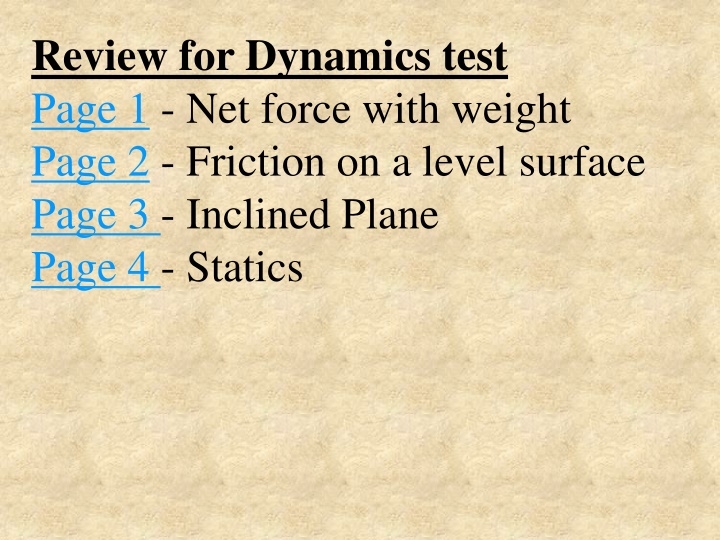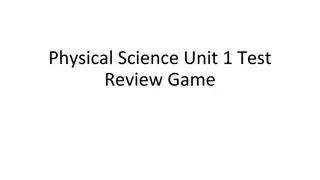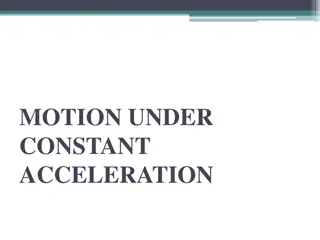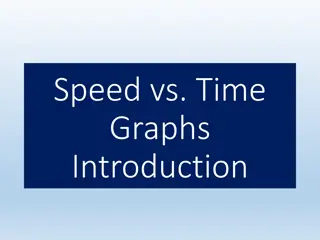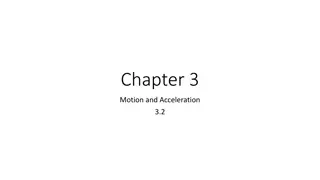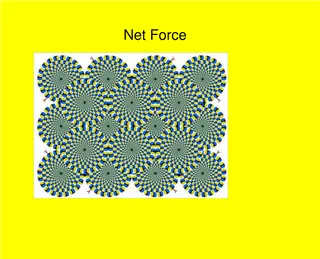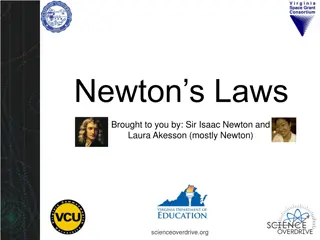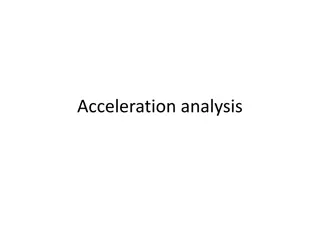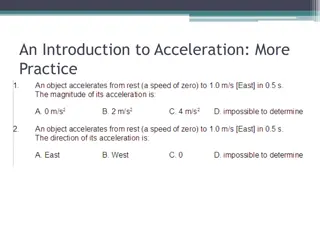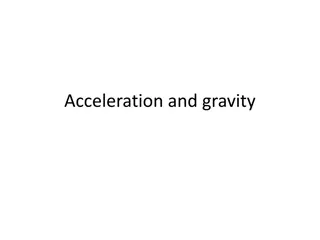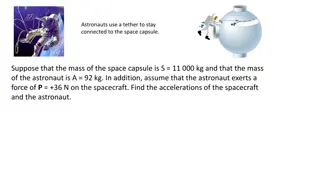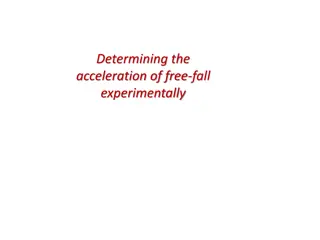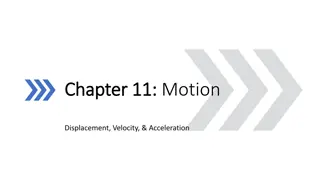Review for Dynamics Test - Net Force and Acceleration Examples
This content provides a review on dynamics topics such as net force, weight, friction, inclined planes, and statics. It includes examples and explanations on elevator problems, net force calculations using weight, free body diagrams, acceleration calculations, and force calculations under different conditions. Images and explanations guide you through understanding these concepts effectively.
Download Presentation

Please find below an Image/Link to download the presentation.
The content on the website is provided AS IS for your information and personal use only. It may not be sold, licensed, or shared on other websites without obtaining consent from the author.If you encounter any issues during the download, it is possible that the publisher has removed the file from their server.
You are allowed to download the files provided on this website for personal or commercial use, subject to the condition that they are used lawfully. All files are the property of their respective owners.
The content on the website is provided AS IS for your information and personal use only. It may not be sold, licensed, or shared on other websites without obtaining consent from the author.
E N D
Presentation Transcript
Review for Dynamics test Page 1 - Net force with weight Page 2 - Friction on a level surface Page 3 - Inclined Plane Page 4 - Statics
Page 1 - elevator problem Acceleration with a certain tension, tension with an upward acceleration, tension with a downward acceleration, tension and acceleration with suvat, tension and acceleration with suvat.
Net Force Example 3 Using Weight 35 N Find the acceleration (on Earth) 5.0 kg TOC
Net Force Example 3 Using Weight 35 N Draw a Free Body Diagram: 5.0 kg -49 N Don t Forget the weight: F = ma = 5.0*9.8 = 49 N TOC
Net Force Example 3 Using Weight F = ma 35 N 49 N = (5.0 kg)a -14 N = (5.0 kg)a a = -2.8 m/s/s 35 N 5.0 kg -49 N TOC
Whiteboards: Using Weight 1 | 2 | 3 | 4 | 5 TOC
Find the acceleration: F = ma, weight = (8.0 kg)(9.80 N/kg) = 78.4 N down Making up + <100. N - 78.4> = (8.0kg)a 21.6 N = (8.0kg)a a = 2.7 m/s/s 100. N 8.0 kg W 2.7 m/s/s
Find the acceleration: F = ma, wt = (15.0 kg)(9.8 N/kg) = 147 N down <120. N - 147 N> = (15.0kg)a -27 N = (15.0kg)a a = -1.8 m/s/s It accelerates down 120. N 15.0 kg W -1.8 m/s/s
Find the force: F = ma, wt = (16 kg)(9.8 N/kg) = 156.8 N down <F 156.8 N> = (16.0 kg)(+1.5 m/s/s) F 156.8 N = 24 N F = 180.8 N = 180 N F 16 kg a = 1.5 m/s/s (upward) W 180 N
Find the force: F = ma, wt = 1176 N downward <F 1176 N> = (120. kg)(-4.50 m/s/s) F 1176 N = -540 N F = 636 N F 120. kg a = -4.50 m/s/s (DOWNWARD) W 636 N
This box is going downwards at 22.0 m/s and is stopped in a distance of 1.85 m. What must be the upwards force acting on it to stop it? F First, suvat: s = -1.85 m, u = -22.0 m/s, v = 0, a = ? use v2 = u2 + 2as, a = +130.81 m/s/s 120. kg F = ma, wt = 1176 N downward <F 1176 N> = (120. kg)(+130.81 m/s/s) F 1176 N = 15697 N F = 16873.2973 = 16,900 N W 16,900 N
Page 2 - Friction on the level Label forces - weight, normal force exerted by surface, friction, applied force Acceleration with an applied force Force to get a certain acceleration Force with suvat
Usually the weight (level surfaces) also be sure to read section 4-6 in the book There are also one with suvat it is like net force #5 and #7 better study them too.
Find the acceleration: 7.0 N 3.0 N 5.0 kg F = ma Making to the right + <7.0 N 3.0 N> = (5.0kg)a 4.0 N = (5.0kg)a a = .80 m/s/s W .80 m/s/s
Find the acceleration: 5.0 N 3.0 N 23.0 kg 6.0 N F = ma <5.0 N 3.0 N 6.0 N> = (23.0kg)a -4.0 N = (23.0kg)a a = -.1739 = -.17 m/s/s W -.17 m/s/s
Find the other force: F = ?? 67.3 N 452 kg a = .12 m/s/s F = ma <67.3 N + F> = (452 kg)(.12 m/s/s) <67.3 N + F> = 54.24 N F = 54.24 N - 67.3 N F = -13.06 = -13 N W -13 N
Find the other force: F ??? 580 N 2100 kg 125 N a = .15 m/s/s F = ma <580 N - 125 N + F> = (2100 kg)(-.15 m/s/s) 455 N + F = -315 N F = -770 N (To the LEFT) W -770 N
Page 3 - Inclined planes Acceleration down the ramp with no friction Force with a certain acceleration down the plane Force with a certain acceleration up the plane Third force exerted with a certain acceleration second force with suvat
26o A 5.0 kg object rests on an inclined plane that makes an angle of 26o with the horizontal. Make up the plane positive. A) What are the components of gravity parallel and perpendicular to the plane? B) Were the block to slide with no friction down the plane, what would be its acceleration? C) What force would make the block slide up the plane with an acceleration of 2.4 m/s/s? (assume no friction) D) What force in what direction would make the block slide down the plane with an acceleration of 5.2 m/s/s? E) Suppose there were a friction force of 9.5 N, what force in what direction would make the block slide down the plane with an acceleration of 1.9 m/s/s?
A 5.0 kg object rests on an inclined plane that makes an angle of 26o with the horizontal. Make up the plane positive. A) What are the components of gravity parallel and perpendicular to the plane? mg sin = F|| = 21.502 N mg cos = Fperp = 44.086 B) Were the block to slide with no friction down the plane, what would be its acceleration? <-21.502> = (5.0)a a = -4.3004 m/s/s (down the plane is -) C) What force would make the block slide up the plane with an acceleration of 2.4 m/s/s? (assume no friction) <-21.502+F> = (5.0)(+2.4) F = 33.502 N (up the plane) D) What force in what direction would make the block slide down the plane with an acceleration of 5.2 m/s/s? <-21.502+F> = (5.0)(-5.2) F = -4.4979 N (down the plane) E) Suppose there were a friction force of 9.5 N, what force in what direction would make the block slide down the plane with an acceleration of 1.9 m/s/s? <-21.502+F+9.5> = (5.0)(-1.9) (friction will oppose the motion) F = 2.5021 N (up the plane)
= 23.5o Find the component of gravity acting into the plane, and the component acting down along the plane: Fperp = mgcos( ) = (4.5 kg)(9.81 N/kg)cos(23.5o) = 40.48 N F|| = mgsin( ) = (4.5 kg)(9.81 N/kg)sin(23.5o) = 17.60 N Note that this makes sense - mostly into the plane W 40.4 N, 17.6 N
+ - = 23.5o The plane is frictionless, so the component of gravity parallel to the plane is unopposed. What is the acceleration of the block down the plane? Fperp = 40.48 N, F|| = 17.60 N, F = ma, <-17.60 N> = (4.50 kg)a a = F/m = F||/m = (-17.58 N)/(4.50 kg) = -3.91 m/s/s W -3.91 m/s/s
+ - = 23.5o What force would make the block accelerate up the plane at 2.10 m/s/s? Fperp = 40.48 N, F|| = 17.60 N, F = ma, <-17.60 N + F> = (4.50 kg)(+2.10 m/s/s) F = 27.053 = 27.1 N W 27.1 N
+ - = 23.5o Suppose it accelerates down the plane at 2.71 m/s/s. What other force is acting on the block? What is the direction? Fperp = 40.48 N, F|| = 17.60 N, F = ma, <-17.60 N + F> = (4.50 kg)(-2.71 m/s/s) F = 5.41 N (up the plane) W 5.41 N up the plane
+ - = 23.5o The block starts from rest and accelerates through a distance of 1.24 m down the plane in .697 s. What other force must be acting along the plane besides gravity? Fperp = 40.48 N, F|| = 17.60 N, F = ma, s = ut + 1/2at2 , a = 2s/t2 = -5.1049 m/s/s <-17.60 N + F> = (4.50 kg)(-5.1049 m/s/s) F = -5.3692 N = -5.37 N (down the plane) W -5.37 N
Page 4 Statics Calculate the equilibrant Vertical equilibrium for a box on a plane with a string supporting some of its weight Two unknowns with matrices - force equilibrium
Force equilibrium: Step By Step: 1. Draw Picture 2. Calculate weights 3. Express/calculate components 4. Set up a <sum of all forces> = 0 equation for x and another for the y direction 5. Do math.
y B = 14 N A = 23 N 56o 29o x Example: Find F, and such that the system will be in equilibrium (This force is called the equilibrant) F x y A B F Sum 0 0 W
y B = 14 N A = 23 N 56o 29o x Example: Find F, and such that the system will be in equilibrium (This force is called the equilibrant) F x 20.12 -7.83 y 11.15 11.61 A B F Sum 0 0 W
y B = 14 N A = 23 N 56o 29o x Example: Find F, and such that the system will be in equilibrium (This force is called the equilibrant) F x 20.12 -7.83 -12.29 0 y 11.15 11.61 -22.76 0 A B F Sum W
y B = 14 N A = 23 N 56o 29o x Example: -22.76 F Mag = (22.762+12.292) 26 N = Atan(22.76/12.29) 62o Trig angle = 180+62 = 242o -12.29 x 20.12 -7.83 -12.29 0 y 11.15 11.61 -22.76 0 A B F Sum W
If F1 is 185 N, what is F2 ? 54 kg First - the box weighs (54 kg)(9.8 N/kg) = 529.2N This is a downward force F1 Next, since there are no forces in the x direction, and there are no components to make, let s set up our Y equation: F1 + F2 - 529.2 = 0, but since F1 = 185 N 185 N + F2 - 529.2 = 0, so F2 = 344.2 N F2 529.2 N (one question like this)
24.0o 62.0o P Q Trig Angles P = 62o Q = 180-24 = 156o Weight of mass: (17.0 kg)(9.81 N/kg) 166.77 N 17.0 kg Force Equations: Pcos(62o) + Qcos(156o) = 0 Psin(62o) + Qsin(156o) = 166.77 Solutions P = 152.7 N Q = 78.5 N TOC P = 152.7 N, Q = 78.5 N
y Q = ? P ? 61o 31o x 81o Find P and Q 34.0 N Step 1 - Set up the horizontal equation (34.0 N)cos(180+81o) = -5.319 N, Pcos(31o), Qcos(180+61o): -5.319 N + Pcos(31o) + Qcos(180-61o) = 0 W -5.319 N + Pcos(31o) + Qcos(180-61o) = 0
y Q = ? P ? 61o 31o x 81o Find P and Q 34.0 N Step 2 - Set up the vertical equation (34.0 N)sin(180+81o) = -33.581 N, Psin(31o), +Qsin(180-61o): -33.581 N + Psin(31o) + Qsin(180-61o) = 0 W -33.581 N + Psin(31o) + Qsin(180-61o) = 0
Step 3 - Do Math: -33.581 N + Psin(31o) + Qsin(180-61o) = 0 -5.319 N + Pcos(31o) + Qcos(180-61o) = 0 Substitution: -33.581 N + Psin(31o) + Qsin(180-61o) = 0, P = (33.581 N-Qsin(180-61o))/sin(31o) -5.319 N + Pcos(31o) + Qcos(180-61o) = 0, substituting: -5.319 N + {(33.581 N+Qsin(180-61o))/sin(31o)}cos(31o) + Qcos(180-61o) = 0 -5.319 N + (33.581 N)/tan(31o) + Qsin(180-61o)/tan(31o) - Qcos(180-61o) = 0 Q = 26.061 = 26 N, P = 21 N Matrices: Psin(31o) + Qsin(180-61o) = 33.581 N Pcos(31o) + Qcos(180-61o) = 5.319 N J K [sin(31o) , sin(180-61o)] [P] = [33.581 N] [cos(31o) ,cos(180-61o)] [Q] = [5.319 N ] Answer matrix will be [J]-1[K] W Q = 26 N, P = 21 N
